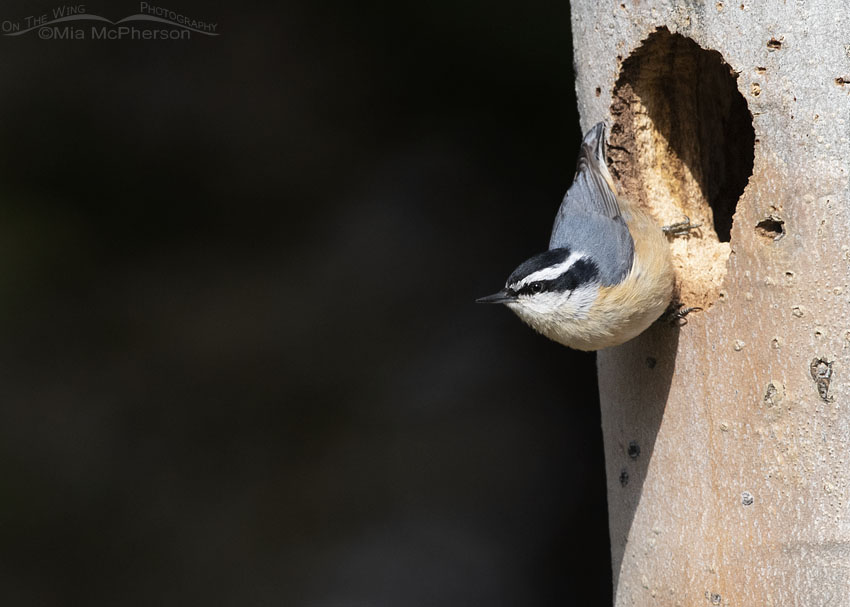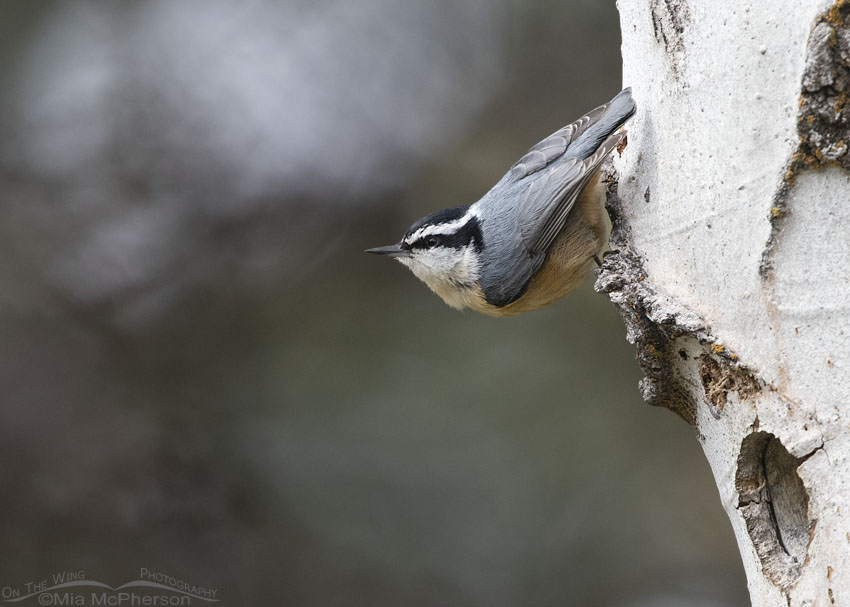 Female Red-breasted Nuthatch checking out a nesting cavity – Nikon D810, f10, 1/1000, ISO 800, Nikkor 500mm VR with 1.4x TC, natural light
Female Red-breasted Nuthatch checking out a nesting cavity – Nikon D810, f10, 1/1000, ISO 800, Nikkor 500mm VR with 1.4x TC, natural light
Three years ago I had just returned from a camping and bird photography trip up to Idaho and Montana where I spent several productive mornings photographing a variety of cavity nesting birds including Mountain Bluebirds, Northern Flickers, Mountain Chickadees, Tree Swallows, Red-naped and Williamson’s Sapsuckers, House Wrens and Red-breasted Nuthatches. By sitting in a mobile blind and being patient I was delighted to watch as some of the birds excavated nesting cavities while others squabbled with each other over the rights to nest in older, existing cavities in a single Aspen tree.
Some of these birds are primary cavity nesters while others are secondary cavity nesters. Tree Swallows, Mountain Bluebirds, House Wrens and Mountain Chickadees are secondary cavity nesters which means they rely or depend on other birds to create the cavities they use to nest in because their bills are not shaped to excavate. Northern Flickers, Red-naped and Williamson’s Sapsuckers all have bills that are shaped to excavate nesting cavities with efficiency and speed.
 Red-breasted Nuthatch in the Targhee National Forest – Nikon D810, f7.1, 1/800, ISO 1000, Nikkor 500mm VR with 1.4x TC, natural light
Red-breasted Nuthatch in the Targhee National Forest – Nikon D810, f7.1, 1/800, ISO 1000, Nikkor 500mm VR with 1.4x TC, natural light
Red-breasted Nuthatches are unique because they will use older, existing nesting cavities or they will excavate new cavities themselves to lay their eggs and raise their young in. Looking at their bills I wouldn’t have thought these small birds with little bills would be able to excavate their own cavities but they can and do. They show a preference to using aspens because aspens have soft wood but they will also use dead trees and live trees that have dead parts. Both the male and female excavate but the females tend to do more excavation than the males. The cavities are between 2.5 and 8 inches deep.
I often hear Red-breasted Nuthatches before I see them, they have what I think are delightful calls and songs.
Right now Red-breasted Nuthatches should be looking for or excavating nesting cavities here in northern Utah which means I should take a trip up to the back roads in the mountains soon and see if I can locate some closer to home than Idaho or Montana. Finding them is the hard part, in a vehicle you have to go slow to watch for the nuthatches flying in the forest or creeping up a tree. Even with keen eyes they can be hard to see.
Drive too fast in a mobile blind and you will miss the Red-breasted Nuthatches or any other woodland birds for that matter, I can guarantee that. Speeding through a forest isn’t productive or helpful when looking for these tiny birds.
Life is good.
Mia
Click here to view more of my Red-breasted Nuthatch photos plus facts and information about this species.


Really incredible colors and the contrasts you captured is just great. Thanks Mia.
What a wonderful sight to see. Bliss.
I do hope you can get out there soon.
It amazes me that their nest cavities are generally perfectly round. How do they DO that without all the tools we have to use? Evidently, we humans are dullards on that issue. Go figure
Dullards on that and so many issues.
Beautiful photos Mia
Great photo and great information on cavity nesting birds!
Good grief, that’s a pretty big nesting hole for such a little bird. Red-breasted Nuthatches are one of my favourite birds. They are so cheeky.
We had a red-breasted Nuthatch or two at our feeders one winter…they loved the suet and seed and we loved seeing them…tiny, cute, friendly little birds…even smaller than our regular Nuthatches or Chickadees.